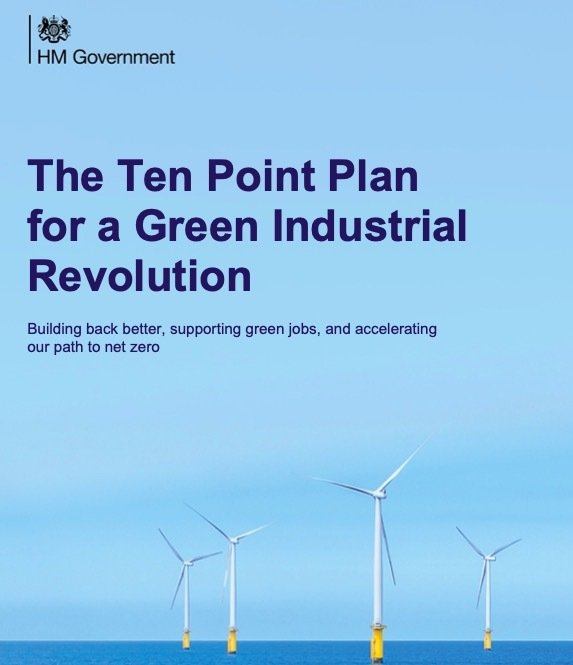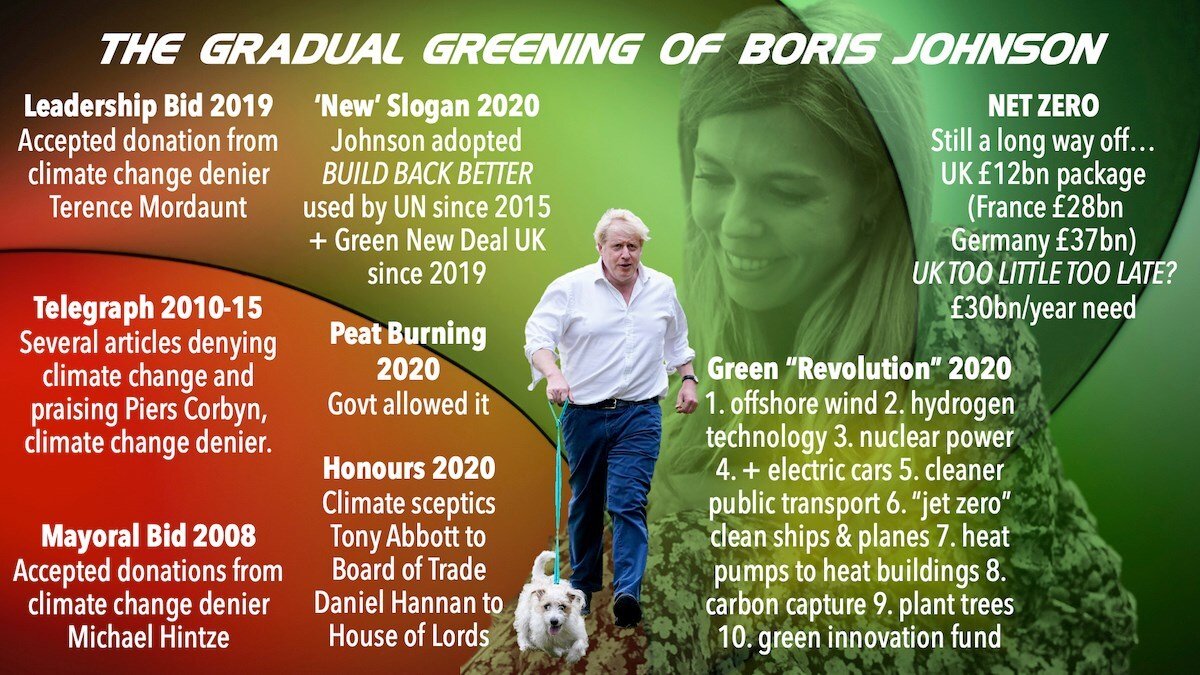
Earlier this week I imagined, not altogether seriously, how Boris Johnson came to create his ten point plan for the climate, or the green industrial revolution, if you like. At the time, there was no detail other than the prime minister’s article in the Financial Times and a shortish press release. Now the government has published its booklet, there is some flesh on the bones to explore.

First, it would be churlish not to welcome some of the big announcements. There are plans to bring forward the date for banning sales of new vehicles running on petrol or diesel to 2030. Of course, this is good news – aside from the fact that hybrids, which run on petrol or diesel, can continue to be sold. A big increase in the number of electric vehicles on the roads is planned … more of which later.
There is also good news in the government’s plans significantly to increase offshore wind power as a source of renewable electricity and to increase the number of charging points for electric vehicles. Indeed, the ‘booklet’ (as the government describes it – isn’t it a green paper?) has a number of these laudable plans included within it. And plans to introduce ground and air-source heat pumps at scale, to replace fossil gas heating for residential buildings, are certainly to be welcomed.
But there are some more problematic proposals, such as nuclear power. Does anyone know when Hinkley Point C is actually going to produce any electricity? The date keeps being pushed further and further back, with the latest date for finishing – 2025. The paper suggests it will be up and running in the “mid-2020s”, giving some more wriggle room. Meanwhile, the government recently announced it was forging ahead with building Sizewell C nuclear power station, using the same troubled design as Hinkley C. However, there is still no long- term solution to the problem of nuclear waste.
What about hydrogen? The prime minister somewhat flippantly suggested we could be using this highly flammable gas to cook on in the future, but how would it be made? The paper proposes the development of projects that produce hydrogen as a ‘low carbon’ fuel. Low carbon is code for ‘slightly greener fossil fuels’. It may involve some sort of technofix to mitigate the greenhouse gas footprint – for example, the fabled carbon capture and storage (CCS), where greenhouse gases, mostly carbon dioxide, are captured at the point of emission (such as power stations) and pumped into subterranean spaces, where they can be stored for evermore. A lot of people are placing a great deal of hope in CCS, but it has yet to be proven to work at the scale needed. Much, much more investment will be needed if CCS is going to make a useful contribution to climate action in the timescale needed.
A far more promising approach to hydrogen is to create it using purely renewable energy: so-called ‘green hydrogen’ as opposed to the low carbon, but still fossil-fuel-derived, blue hydrogen. There is, effectively, a limitless supply of electrolyte (sea water), so applying electricity from wind or solar farms could produce all the hydrogen anyone could ever need, with as near to a zero-climate footprint as makes no difference. The Department for Business Energy and Industrial Strategy (BEIS) has funded a project called Gigastack, developing the technology to produce green hydrogen – but the funding is minute, just £7.5m from a £90m fund, from which most of the money has gone to fossil hydrogen projects.
Point 5 of the plan about green public transport, cycling and walking is perhaps the most exciting of all the proposals. There are plans to invest billions into electrifying the train network, into city transport and zero carbon buses – plus properly segregated cycle lanes and low traffic neighbourhoods. However, once the initial wave of excitement passes, it is important to look at the track record of this government and its prior incarnations back to 2010. Rail electrification has stalled since then. Traffic volumes have increased. The size of cars has increased dramatically. The Covid-19 pandemic has driven a stake through the heart of public transport, and it will take something dramatic to get people back to using it again even after we have all been vaccinated. Cycle lanes and low traffic neighbourhoods that have been introduced this year have generated a vicious backlash from the motoring lobby. For these ‘green revolution’ plans to really happen, the government will need to mandate local authorities with the powers – and duties – and, crucially, the funding. Otherwise it will be another well-meaning pipe dream to add to the pile. It’s not as though this is new, after all.
What about the really green – to be specific, the ‘nature’ – element of the green industrial revolution? Much energy has been expended lately among quangos, think tanks and NGOs talking up ‘nature-based solutions’ to impending climate chaos. Simply put, this means encouraging natural processes to better absorb all those greenhouse gases we – and that is we in the industrialised north of the globe – have been merrily adding to the atmosphere over the past 200 years (but especially the last 40).
This bit of the plan is a bit thin, to be honest. The now well-worn 30,000 ha of new tree-planting target is wheeled out – and, of course, this comes with its own special set of problems, as I illustrated recently. It was also evident that the department in charge of writing the plan, BEIS, had not really checked what they had written with Defra, the environment department. BEIS must have picked up on Defra’s plans to create new areas of outstanding natural beauty (AONB) and national parks and decided that this, in itself, would lead to lots more carbon being locked up – in trees, presumably. The two are at present unrelated. Creating new AONBs and national parks will not lead to any additional carbon being absorbed, unless their remits are drastically changed. Turning the Chilterns into a national park, for example, will not lead to it being covered in trees – at least, not any more than are already there. Plenty of those are currently being chopped down, thanks to HS2.
BEIS also got confused when considering flood defences, thinking that this should be included under the heading “protecting our natural environment”. In most cases, the opposite is true, with hard-engineered flood and coastal defences, and the dredging that goes with them, actively damaging the natural environment to protect human habitation. Natural flood management was alluded to, but of the £5.2bn budget for flood and coastal defence mentioned, only a few million has so far been allocated to natural flood management projects.
So much for the detail (and, yes, I have skipped over some of the points in the name of brevity). What about the fundamentals?
The well-respected climate think tank, Carbon Brief, has done the maths and concluded that, adding all of the proposals in this revolutionary plan together gets halfway to the 2032 waymark the Government has already set down on the path to net-zero by 2050.
Perhaps even more fundamentally, the plan is based on the idea that economic growth will pay for the damage to the environment caused by … economic growth. It assumes we can continue to live our current lifestyles without any changes. It assumes that we can continue to travel just as much in our electric cars as we do in our petrol cars. It assumes we can continue to consume as much stuff as we do now without any cost.
In this sense the revolution is anything but. It’s business as usual plus a bit of tinkering – and it will not solve our most pressing, or long-term, problems.
But that isn’t to say it should be dismissed. It indicates a recognition from within government that we have serious environmental problems which need to be addressed. And given the backlash against these proposals from elements of the media and the political right, its intentions should be welcomed. After all, it was only a few years ago that Boris Johnson was favourably quoting Covid-19 and climate denier Piers Corbyn on how the sun controls the climate.
At least now our prime minister appears to be signed up to the need for climate action.






